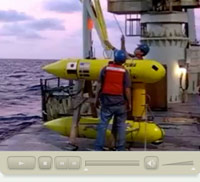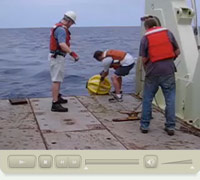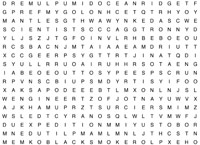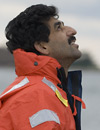|
  Today's Weather Cloudy, passing showers Lat: 04° 02’S Long: 12° 15’W Air Temp: 77.5°F Bar Pressure: 1011.5 mbar Sea Temp: 79.6°F Sea State: 4-6 ft Swell Height: <7 ft, SE Wind: SSE; 11-16 knots Visibility: Unlimited
Puma Gets Ready for the Hunt! It was another long night for our CTD When you get an Eh “hit” you know you’re pretty close to a hydrothermal The long hours paid off. In the early morning, as the CTD approached the “hit” site, the Eh, temperature, and water clarity signals showing on the shipboard computer screen went crazy. In fact, the Eh signal was more than four times the size of the previous one (see slide 1 in today’s slideshow)! Then it’s tag-team time: the CTD team went to their bunks to take a well-deserved rest, and the AUV navigation team stepped up to the plate. With our survey area now much better defined, the navigation team sent two transponders After their two-hour descent to the sea floor, engineer Mike Jakuba spent most of the day defining the location of the transponders using the Knorr’s GPS system. He piloted the ship to an assortment of positions in a rough circle around each transponder, and signaled them to send him back a “ping.” The time it took for the “ping” to return indicated how far away the transponder was from the ship at these various locations—a distance called the “acoustic slant range.” By piloting the ship in a circle around each transponder, and knowing the ship’s position very accurately with the GPS, Mike can determine the location of each transponder with great precision. Finally, it is time to let one of the “cats” loose. Puma took a couple of dips this evening to check its ballast and run some tests to make sure all systems are a “go” and that data from its sensors are being transmitted. “It is great getting data back from the vehicles on these tests in real time,” said marine geophysicist Rob Reves-Sohn. “This is a big step forward, and it feels good to be part of it.” Overnight, Puma will recharge its batteries and the engineers will work on a couple of software glitches discovered during the test dives. In the morning, Puma will embark on a 12-kilometer-long (7.5 mile) mission, running NE-SW survey lines in a box about 2 kilometers by 1 kilometer (1.2 miles by 0.7 miles) (see slide 7 of today’s slideshow). You may remember that yesterday we said the “bull’s eye” would measure 4 kilometers by 4 kilometers. Thanks in part to the great success of the CTD work, we were able to narrow down the target even more, and this smaller search area means a greater chance of success given Puma’s battery power, which can last for 7.5 miles. Puma will “swim” at a depth of about 3450 meters—mapping the hydrothermal plume so we can home in on its seafloor source. Read the new interview Hanumant Singh: Hanu Singh, an ocean engineer at Woods Hole Oceanographic Institution and leader of the team that built Puma and Jaguar, is the Chief Scientist on the current expedition. Learn more about Hanu, and hear his perspective on why this cruise is important in improving the way research at sea is carried out. Read the interview »
[ Previous day ] [ Next day ]
|
||
Mailing List | Feedback | Glossary | For Teachers | About Us | Contact
© 2010 Dive and Discover™. Dive and Discover™ is a registered trademark of Woods
Hole Oceanographic Institution





